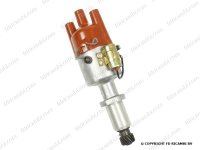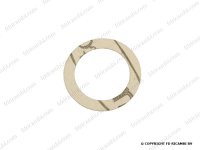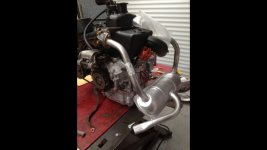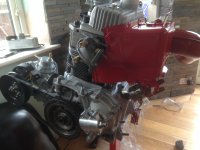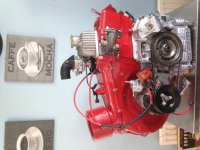So I’m putting a new 123 distributor on my rebuilt 126 650 engine and not sure of a few things.
First off, looks like I got the full ignition and distributor kit; I thought I was getting one that was fully electronic with a dummy distributor cap, but looks like it’s a conventional cap and there’s a rotor inside. No points or condenser. The unit has only one black and one red wire that attach to the coil; no blue ground wire. Incidentally, the instructions are useless - they are for models without the cap and rotor (where timing is set with a set screw and flashing LED), and with a blue wire. They don’t apply to my model.
1. Spacer - the kit came with a spacer and new hold down clamp. I compared the rebuilt 126 engine’s conventional distributor to it and it looks like the 123 kit is meant to be used without the spacer (otherwise with the spacer it would be too short). I think the spacer is for using the same distributor on a 500 engine. I did notice that the distributor’s collar (where the hold down clamp touches down) has a notch in its edge that looks like it’s supposed to accommodate the hold down clamp bolt. It isn’t necessary for that and the cut out actually looks like it would allow a tiny open gap against the crankcase that might let oil out. I used the circular paper gasket from my rebuilt engine’s distributor and clamped it on, but it doesn’t seem right to me. Anyone know if this is normal?
2. How to set timing? Since this distributor has no electronic set screw for timing, is it just a matter of rotating it until the engine runs smoothly? Or using a timing light?
3. No blue wire - I’m assuming that is normal and the ground is coming from the negative (1) side of the coil, which is grounded.
Thoughts appreciated!
First off, looks like I got the full ignition and distributor kit; I thought I was getting one that was fully electronic with a dummy distributor cap, but looks like it’s a conventional cap and there’s a rotor inside. No points or condenser. The unit has only one black and one red wire that attach to the coil; no blue ground wire. Incidentally, the instructions are useless - they are for models without the cap and rotor (where timing is set with a set screw and flashing LED), and with a blue wire. They don’t apply to my model.
1. Spacer - the kit came with a spacer and new hold down clamp. I compared the rebuilt 126 engine’s conventional distributor to it and it looks like the 123 kit is meant to be used without the spacer (otherwise with the spacer it would be too short). I think the spacer is for using the same distributor on a 500 engine. I did notice that the distributor’s collar (where the hold down clamp touches down) has a notch in its edge that looks like it’s supposed to accommodate the hold down clamp bolt. It isn’t necessary for that and the cut out actually looks like it would allow a tiny open gap against the crankcase that might let oil out. I used the circular paper gasket from my rebuilt engine’s distributor and clamped it on, but it doesn’t seem right to me. Anyone know if this is normal?
2. How to set timing? Since this distributor has no electronic set screw for timing, is it just a matter of rotating it until the engine runs smoothly? Or using a timing light?
3. No blue wire - I’m assuming that is normal and the ground is coming from the negative (1) side of the coil, which is grounded.
Thoughts appreciated!


